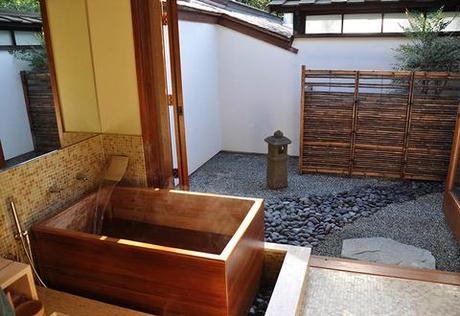Tubs are traditionally made of Hinoki - used for centuries to build Shinto temples. Its American cousin is Port Orford Cedar, and both woods are prized for their antiseptic properties – sushi chefs use them for chopping boards. Both also release a wonderful lemon ginger scent in a cloud of relaxing steam as the tub fills. Hinoki oil is a staple of aromatherapy and some people say it helps congestion and asthma. Other popular woods are sweet-smelling Alaskan Yellow Cedar and Western Red Cedar, as well as sustainably-harvested teak, a dark wood with a neutral scent.
Slideshow
This owner created an enclosed garden to enjoy his soaking tub, enhancing the feel of a private sanctuary by carefully placing a mirror that reflects a lantern and path. Zen BathWorks in Alaska (formerly Sea Otter Works) made this Red Cedar tub, and sometimes has popular sizes ready to ship. Notice the drain to capture water flowing over the top. Photo courtesy of: Zen BathWorks
Q & A with Bill Finlay of Zen BathWorks, based in Haines, Alaska
Jennifer Aniston chose a tub from his company when she remodeled her house, and Bill recently sent one to Virgin Group chairman, Sir Richard Branson. Other manufacturers report increasing sales to celebrity clients and regular homeowners alike, and ofuro makers are experienced at shipping worldwide and providing design and installation information.
Why should I think about getting an ofuro?
The ofuro is the perfect balance of simplicity, beauty, aromatic wood and deep hot water!
How are Japanese soaking tubs, ofuros, different from American tubs?
They are much deeper which lets you sit naturally upright, so the tub doesn't need to be very long. The traditional tub is made with beautiful Hinoki wood, which fills the room with a lovely lemony aroma with every bath.
How did you get into the bathtub business?
A client asked me to build an ofuro many years ago, so I made a trip to Japan to learn about them.
How much is a tub and can I customize it?
The price range is $5 to $10 K, and we do a lot of custom work. We offer consulting services to help with the design process.
What are important questions to ask a tub maker?
Ask how the tub is made and about the guarantee. Avoid solid-wood planked designs. We use our proprietary engineered wood panels that are designed to remain stable in a bathtub. Our tubs are guaranteed.
How do I know which wood to choose?
Hinoki makes a perfect tub. Light tan in color. Teak is a beautiful mocha color, very durable, with a neutral aroma. Western Red Cedar is a colorful reddish brown, with a pleasant sweet cedar aroma
How do I keep a wooden tub clean?
We have made the ofuro user-friendly! All it takes is a quick rinse after each use.
How long does it take to make and do you have some in stock?
Our lead-time is 5 to 7 weeks. We try to have some stock on hand.
